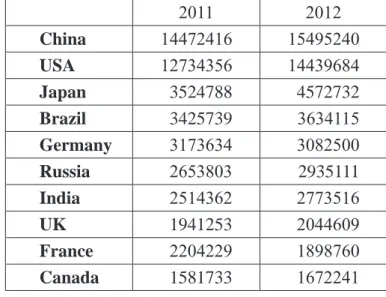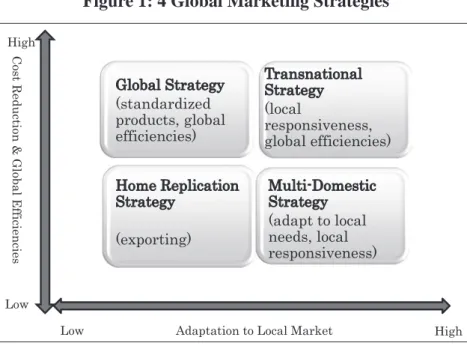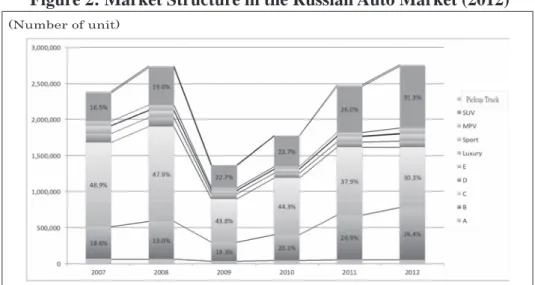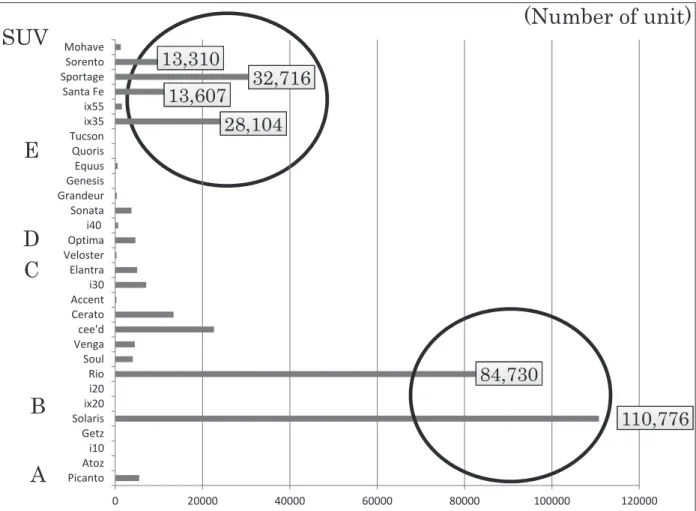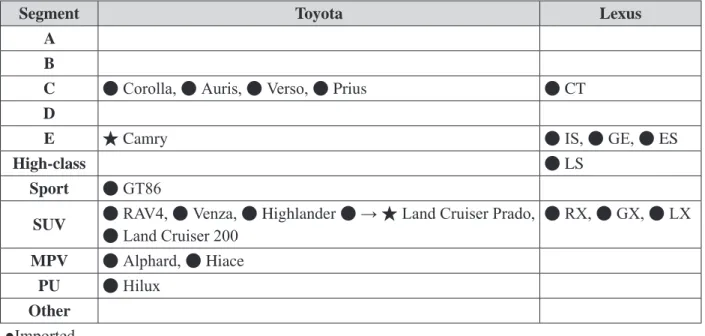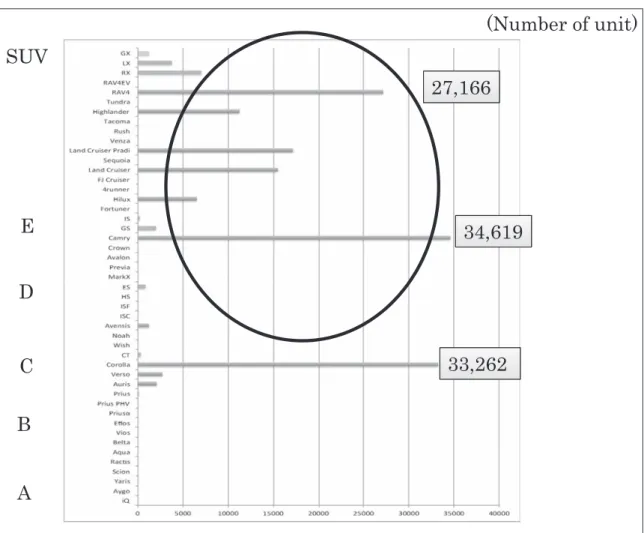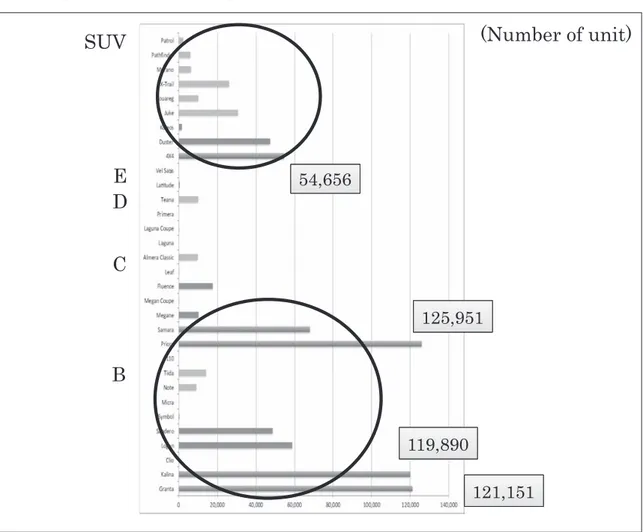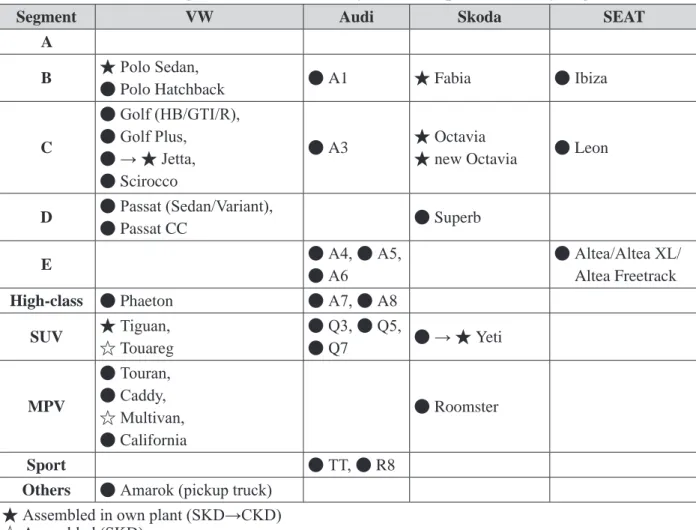How do the Marketing Strategies of Major Foreign Automobile Manufacturers in the Russian Market Differ?
Eiko Tomiyama
Professor, Graduate Institute for Entrepreneurial Studies Abstract
This paper provides a comparative verification of the methods used by major automobile manufacturing groups–namely Hyundai-Kia, Toyota, Renault-Nissan-AvtoVAZ, VW, and GM – in their approach to the automobile market in Russia, which is the world’s sixth-largest in terms of the number of passenger cars sold. More specifically, it examines their modes of entry, the products they have introduced, and their sales trends. Then, this paper analyzes the differences and similarities between the strategies of each group in Russia, based on the “the Integration- Responsiveness Framework” in order to identify the ways in which the strategies of each group differ.
Keyword: Integration-Responsiveness Framework, TOYOTA, Hyundai, VW, Renault-Nissan- AvtoVAZ, GM, marketing, outsourcing
1. Introduction
Russia is the world’s sixth-largest market in terms of the number of passenger cars sold, behind China, the USA, Japan, Brazil, and Germany (Table 1). The groups doing battle in this market are Hyundai-Kia of the ROK, Toyota, Renault-Nissan-AvtoVAZ, VW, and GM (Table 2).
The objective of this paper is to conduct a comparative verification of the methods used by these automobile manufacturing groups in their approach to the Russian market; more specifically, it examines what modes of entry they used, what products they introduced to the market, and what the trends in the sales of their products are.
Table 1: Auto Sales in Major World Countries (2011/2012)(number of unit)
2011 2012
China 14472416 15495240
USA 12734356 14439684
Japan 3524788 4572732
Brazil 3425739 3634115
Germany 3173634 3082500
Russia 2653803 2935111
India 2514362 2773516
UK 1941253 2044609
France 2204229 1898760
Canada 1581733 1672241
Source: FOURIN (2013a), p.16.
Table 2: Auto Sales in Russia by Automakers and Brand (2008 to 2012)
(number of unit)
Manufacturer Brand 2008 2009 2010 2011 2012 Share
Renault-Nissan- AvtoVAZ
Lada 622,182 324,490 522,924 578,387 537,625 18.3
Renault 108,070 72,284 96,466 154,734 189,852 6.5
Nissan 146,548 64,221 79,614 138,827 153,747 5.2
Infiniti 7,793 4,630 4,674 7,042 9,209 0.3
Renault-Nissan total 262,411 141,135 180,754 300,603 352,808 12 Renault-Nissan-AvtoVAZ
Group total 884,593 490,625 703,678 878,990 890,433 30.3
GM
Chevrolet 235,466 104,398 116,233 173,484 205,042 7
Opel 98,800 34,277 40,875 67,555 81,242 2.8
Cadillac, etc. 3,544 3,020 1,459 2,226 2,024 0.1
Western brands total 337,810 141,695 158,567 243,265 288,308 9.8
Daewoo 95,510 51,414 74,419 92,778 88,232 3
GM Group total 433,320 193,109 232,986 336,043 376,540 12.8
Hyundai Motor Company
Hyundai Motor Company 192,719 74,607 87,081 163,447 174,286 5.9
Kia 88,152 70,088 104,235 152,873 187,330 6.4
Hyundai Motor Company
Group total 280,871 144,695 191,316 316,320 361,616 12.3
VW
VW 61,026 45,138 66,216 130,348 180,863 6.2
Skoda 50,733 33,002 45,631 74,074 99,062 3.4
Audi 17,076 15,009 18,510 23,250 33,512 1.1
Seat 2,182 869 955 1,127 2,500 0.1
VW Group total 131,017 94,018 131,312 228,799 315,937 10.8
Toyota
Toyota 189,966 68,731 79,315 119,505 153,047 5.2
Lexus 14,796 6,400 10,981 13,698 15,653 0.5
Toyota Motor Group total 204,762 75,131 90,296 133,203 168,700 5.7 Source: FOURIN (2013a), p.39.
2. Literature Review
If global marketing is defined as “simultaneous marketing in multiple markets in multiple countries,” then global marketing has the two dimensions identified by Porter (1986):
configuration and coordination. More specifically, it consists of a configuration strategy, focused on the types of products and the way in which the market was entered with them, and a coordination strategy, which involves STP or a 4P strategy in the target country being implemented from the perspectives of standardization and localization, with know-how being transferred to and shared in that country.
Russia is one of the BRICs countries, but its population is not as big as the other members
of this group and it has a high rate of inflation. There is a high level of political risk and it has
been viewed as a difficult market due to both economic and political uncertainty. Nonetheless,
major automakers such as VW, Toyota, GM, Hyundai and Renault-Nissan were targeting the
Russian market until 2012. All of them have a substantial market share in their respective
categories and view Russia as a major market for the long term. What approach did they take
toward Russia until 2012?
2.1 Integration-Responsiveness Framework
There are many studies analyzing business, functions , tasks and organizations etc. based on “Integration-Responsiveness Framework” (Bartlett, C.A. (1985), Prahalad, C.K., and Doz, Y.L. (1987), Makhija, Mona V., Kim, Kwangsoo and Williamson, S.D. (1997), Ghoshal, S. and Nohria, N. (1993), Cavusgil, S.T., Knight, G.A., and Riesenberger (2011)).
For example, Cavusgil, S.T., Knight, G.A., and Riesenberger (2011) argued that global firms coordinate their value-chain activities across many countries in order to maximize efficiency, effectiveness, flexibility, and learning. Global integration promotes learning and cross- fertilization and reduces wasteful duplication across the firm’s operations worldwide.
On the other hand, firms attempt to meet the specific needs of customers in individual countries and adapt to the local distribution structure. Firms prefer a global integration approach, but some degree of local responsiveness is necessary, because there are differences in individual markets. Given diversity in local customer needs, differences in distribution channels, local competition, and cultural differences, companies need to think about adapting to local markets.
There are 4 global marketing strategies to compete in international markets as follows.
(Figure 1)
Figure 1: 4 Global Marketing Strategies
Home Replication Strategy
This is based on simple exporting. The purpose of international business is viewed as being to generate additional sales for domestic products. Products are designed with domestic customers in mind. They are not adapted for foreign markets. The firm focuses entirely on technology and aims to transfer knowledge and specialist skills to the less-advanced region.
Multidomestic Strategy
The company’s headquarters delegates considerable autonomy to the country managers,
Source: Compiled by the author on the basis of Cavusgil, S.T., Knight, G.A., &
Riesenberger (2011), Porter, M.(1985) ,and Bartlett C.A. & Ghoshal,S.(1989).
Global Strategy (standardized products, global efficiencies)
Transnational Strategy (local
responsiveness, global efficiencies) Home Replication
Strategy (exporting)
Multi-Domestic Strategy
(adapt to local needs, local responsiveness)
Adaptation to Local Market
Low High
Cost Reduction & Global Efficiencies
Low High
Figure 1. 4 Global Marketing Strategies
Source: Compiled by the author on the basis of Cavusgil, S.T., Knight,
G.A., & Riesenberger (2011), Porter, M.(1985) ,and Bartlett C.A. & Ghoshal,S.(1989).
allowing them to operate independently and pursue local differences. The managers adapt products and practices to suit local conditions, and function independently. Individual markets are disconnected and there is no coordination or integration of national markets. Firm operates as a collecting of relatively independent subsidiaries.
Global Strategy
The company’s headquarters pursues global integration. It seeks to control country operations in order to minimize duplication and maximize efficiency, effectiveness, and learning worldwide. The firm emphasizes centralized coordination and control of R&D, production, marketing, and after-sales service. Management views the world as one large marketplace. The firm offers standardized products, using standardized marketing. The main advantages of this approach are lower costs and easier management.
Transnational Strategy
The company has a local base that brings together all three of the aforementioned types of elements, modifying them to meet local market needs. In addition, rather than running the local base as a central branch office, the company uses local know-how as a key weapon for seizing business opportunities. The firm attempts to achieve a balance between global and multidomestic strategies. It applies the model ‘standardize whenever possible; adapt when necessary.’
There is no specific dominant strategy among the four models described above and the category applicable to a single company differs from one case to another, depending on the products handled by that company and its marketing strategy.
In the Integration-Responsiveness framework in the automotive industry, there is substantial pressure both to adapt to the market in each country and to undertake local adaptation. Despite the need to adapt, these markets are full of players pursuing integration via world-beating business operations. As such, they present a harsh environment in which companies must adapt to the market while maintaining the benefits of global integration. Manufacturers engage in strategic local adaptation to regions and countries in each market (Kotosaka (2014)
1). Accordingly, this paper analyzes their product policies.
3. Research Tasks
The tasks set for the research described in this paper are as follows.
a. Conducting a comparative verification of what modes of entry the 5 groups of automakers employed, what products they introduced in which categories, and what the resultant trends in their sales were.
b. Classifying their strategies in Russia in terms of Integration-Responsiveness frameworks
and examining the reasons for adopting strategies of this nature.
4. Methodology
We use the following methods of analysis.
Firstly, we cannot obtain systematically-collected statistics on price segments. Therefore, we first observed changes in the segmentation basis. Next, we carried out data analysis based on statistical data, along with a review of relevant literature. We focus on sales in the volume zones (B, C and SUV segments) and vehicles tailored specifically to the Russian market.
Secondly, we carried out interview-based surveys in Japan, the ROK, and Russia between 2008 and 2014 (Toyota Russia, the Russia Office at Toyota’s head office, Hyundai Motor Company (departments involved with product planning, Russia, and global marketing), Nissan Russia, Hyundai dealers(3 in St. Petersburg, 1 in Khabarovsk), Toyota dealers (Moscow, 2 in St.
Petersburg, Vladivostok, and Khabarovsk), a Lexus dealer (1 in Moscow), Sollers Vladivosotok, Sollers-Bussan, GM Korea in the ROK, a Renault dealer in St. Petersburg, AvtoVAZ dealers in St. Petersburg and Khabarovsk, and a Nissan dealer (Khabarovsk), AvtoVAZ in Tolyatti and Nissan head office).
5. Russian Automobile Market and Marketing Strategies of Major Foreign Automobile manufacturers
5.1 Russian Automobile Segments
As can be seen from Figure 2, which shows sales and the share of passenger cars by segment in Russia (2007-2012), the SUV segment has increased from 16.5% (2007) to 31.3%
(2012). The B-segment has also increased from 18.0% (2007) to 26.4% (2012), but the C-segment has decreased from 48.9% (2007) to 30.3% (2012). Factors behind the popularity of SUVs include road conditions, as Russia has many rough roads, as well as the very low temperatures in winter, the nature of leisure activities, and the emphasis on external appearance.
The growth in the B-segment is due to the increasing popularity of moderate-sized sedans that are not too small and with affordable price.
Figure 2: Market Structure in the Russian Auto Market (2012)
(Number of unit)
Source: Graph compiled by author, using figures from FOURIN (2013), p.66-71.
5.2. Marketing Strategies of Major Foreign Automobile manufacturers 5.2.1 Hyundai
Hyundai Motor Company began knocked-down production based on a licensing agreement with a local company, TagAZ. Subsequently, in 2011, it established its own plant (HMMR) in St.
Petersburg and in 2012 it increased production of two low-priced compact sedans (B-segment) designed specifically for the Russian market: the Hyundai Solaris and the Kia Rio. Both models are selling well: the Solaris was the fourth most-popular model in terms of sales in the Russian market in 2012 (around the 111,000 vehicles mark), while the Rio is the sixth most-popular (around the 85,000 vehicles mark). The Rio shares a platform with the Solaris. The distance between the ground and the bottom of the car has been increased to 16cm, taking into account the depth of snow that accumulates on the roads in winter. Furthermore, in order to prevent rusting due to humidity, the bottom of the car is treated with a corrosion inhibitor. As many Russian roads are poor, the spare tire is a full-sized one. The cars are also equipped with a windshield wiper de-icer, an emergency braking alarm, front seat heaters, de-icing mirrors, and a powerful battery
2.
Kia Motors Corporation began outsourcing knocked-down production to the local Avtotor assembly plant in Kaliningrad in 2000. The models whose assembly is outsourced to Avtotor include the Soul, Venga, cee’d, Cerato, Optima, Quoris, Sportage, Sorento, and Mohave. As a result, supply has expanded swiftly and the company has been able to enter the Russian market and increase its market share. Hyundai-Kia is maintaining good sales figures by enhancing its product line-up of the popular B-segment and SUV models, making full use of imports, outsourced production, and local production (Table 3). Thus, rather than focusing solely on its own plants, the group intends to increase its production capacity within Russia to more than 400,000 vehicles by making effective use of local companies such as TagAZ, Avtotor, and Kuzbass Avto.
Figure 3 shows sales of passenger cars by segment in Russia in 2012. The B-segment, which includes the Solaris and the Rio, and the SUV segment (Sorento, Sportage, Santa Fe, and ix35) are selling very well. As a result, the number of vehicles sold by Hyundai Group in Russia rose to around the 362,000 mark in 2012, accounting for a market share of just over 12%.
Excluding the ROK, Russia is the Hyundai Group’s biggest market after China and the USA, so it occupies an important position in the group’s global growth strategy
3.
Hyundai-Kia’s strategy involves consolidating platforms and diversifying models. After the two companies joined forces in 1999, they consolidated and integrated their 22 existing platforms into six shared platforms. They then used these integrated platforms to develop and sell models tailored to the attributes of each market (BRICs). They have also embarked upon a bold strategy of modularization. Modularization involves outsourcing the sub-assembly of a vehicle to a supplier as a single large integrated component.
Hyundai-Kia’s bold modularization strategy encompasses not only the final assembly
process, but also the welding process. Russia’s main market segments are the B and C segments,
where Hyundai-Kia’s strength lies, so it has many competitive models.
Table 3: Passenger Car Models Sold by Hyundai & Kia in Russia, by Segment
Segment Hyundai
Kia
A ●Picanto
B ★Solaris, ☆Accent, ●i20 ★Rio, ☆Soul, ☆Venga C ●i30, ●Elantra, ●Veloster ☆cee’d, ☆Cerato
D ☆i40, ☆Sonata ☆●Optima
E ●Genesis ☆●Quoris
High-class ●Equus
SUV ●ix35, ●ix55, ☆●Santa Fe ☆Sportage, ☆Sorento, ☆●Mohave MPV ●H-1
Sport ●Genesis Coupe Other
★Assembled in own plant
☆Outsourced assembly
● Imported
Source: FOURIN (2013b), p.121.
Figure 3: Major Passenger Cars Sold by Hyundai & Kia in Russia, by Segment (2012)
0 20000 40000 60000 80000 100000 120000
PicantoElantraCeratoAccentSolarisVengacee'd GetzAtozSoulix20 i30Rioi10i20 VelosterOptimaSonata i40 GrandeurSportageSanta FeMohaveSorentoGenesisTucsonQuorisEquusix35ix55
110,776 84,730
32,716 28,104 13,607
13,310
B C D E SUV
A
Figure 3. Passenger Cars Sold by Hyundai & Kia in Russia, by Segment (2012)
Source: Compiled by the author. using figures from FOURIN (2013),p.66-71.
(Number of unit)
Source: Compiled by the author. using figures from FOURIN (2013), p.66-71.
5.2.2 Toyota
Toyota established Toyota Motor Manufacturing Russia (TMMR) in St. Petersburg in 2005 and began to produce the Camry (E-segment) in 2007. In February 2013, Toyota began using the SKD (semi-knock-down) approach to produce the Prado in Vladivostok. The licensee is Sollers- Bussan (a joint venture between Mitsui & Co., Ltd. and Sollers, which each contribute 50% of the capital).
Toyota is mainly focused on expanding sales of products that are in a higher price range, such as the Camry, but the growth rate in terms of the number of vehicles sold is not as high as that of VW or Hyundai-Kia. Toyota’s emphasis is on sales revenue, so it attaches importance to expanding sales of high-priced products, including its Lexus models. According to Toyota Russia, its stance is that “In light of the physical distance from Japan and Russian government policy, Toyota’s battleground is the C-segment and above. All we need to do is to provide products and services that please our customers. Compared with the European contingent, which has a strong presence in the compact car segment, Toyota’s superiority in Russia lies in making use of its global resources, in the form of large cars.
4” In other words, it has a strategy of beating the competition in the large car segment, which is where its strength lies.
The only vehicle that Toyota produces locally is the Camry, with all other models that it has introduced to the Russian market being imported (Table 4). Consequently, its prices are higher than those of competing companies. According to FOURIN (2013), imports of the B-segment Yaris have ceased due to poor sales, having peaked at around the 5,700 vehicles mark in 2008. As can be seen from Figure 4, Toyota enjoys good sales in the C-segment and above. In particular, its sales are healthy in the E-segment, which is the basis of its local production. Although it does not sell many Lexus, the profit margin on these vehicles would appear to be high.
Toyota is not targeting the volume zones, so it has not introduced any vehicles tailored to the local market. Toyota delivers the knocked-down parts to Sollers-Bussan in Japan and Sollers- Bussan then has responsibility for logistics and assembly. Accordingly, it is an approach that involves hardly any risk
5. Toyota finished SKD of Prado in Vladivostok in June 2015.
Table 4: Passenger Car Models Sold by Toyota & Lexus in Russia, by Segment
Segment Toyota Lexus
A B
C ●Corolla, ●Auris, ●Verso, ●Prius ●CT
D
E ★Camry ●IS, ●GE, ●ES
High-class ●LS
Sport ●GT86
SUV ●RAV4, ●Venza, ●Highlander ●→★Land Cruiser Prado,
●Land Cruiser 200
●RX, ●GX, ●LX
MPV ●Alphard, ●Hiace
PU ●Hilux
Other
●Imported
★Cars assembled in own plant
●→★Land Cruiser Prado in transition from imports to local assembly
Source: FOURIN (2013b), p.126.
Figure 4: Major Passenger Cars Sold by Toyota & Lexus in Russia,by Segment (2012)
5.2.3 Renault-Nissan-AvtoVAZ
Nissan established Nissan Motor Rus in St. Petersburg in 2004. It began to produce the Teana in 2009, the X-Trail in 2010 and the Murano in 2011. Renault agreed that it would establish a CBU production factory jointly with the Moscow city government in 1998. The Avtoframos plant began operating in April 1999, when it started producing the Renault Symbol.
Production of the Logan started in 2005 and production of the Duster in 2009. In 2012, Renault acquired full ownership of the Avtoframos plant. The Almera, which is a model tailored specifically to the Russian and CIS markets, started to be produced in January 2013. The Almera, which is produced in the Tolyatti factory of AvtoVAZ, is a four-door sedan seating five passengers and although it is positioned in the B-segment, it has the kind of cabin space more common in the D-segment Toyota Crown. Because the Almera can withstand the severe winter climate and bad condition of the roads, while offering the best handling performance and ride comfort in this class, it satisfies the needs of Russian customers. It has a base price of 429,000 rubles (approximately 1,330,000 yen). Furthermore, sales of two models under the Datsun brand began in March 2014. These models mainly target entry-level buyers. The price is in the range 300,000-350,000 rubles (930,000-1,085,000 yen).
AvtoVAZ has its origins in a car factory established in Tolyatti near the Volga River in 1966 by the Soviet government, in collaboration with Fiat. It originally produced models to
B C D E SUV
A
34,619
33,262 27,166
(Number of unit)
Source: Compiled by the author. using figures from FOURIN (2013), p.126.
be sold under the Lada brand. The GM Auto joint venture with GM was launched in 2001 and the plant started producing the Chevrolet Niva in 2002. AvtoVAZ embarked upon a strategic partnership with Renault in 2008, with Renault acquiring 25% of the stock in AvtoVAZ. Renault- Nissan agreed with AvtoVAZ that Renault-Nissan would acquire management rights over AvtoVAZ in May 2012. As can be seen from Table 5, this group has introduced a full range of cars, except in the A-segment. Local production is mainly focused on the B-, C- and SUV segments (Table 5). As can be seen from Figure 5, the B- and SUV segments are selling very well. It is expected that the scale of production will increase as a result of the tie-up between the three companies. AvtoVAZ utilizes partner platform technology and is making progress with efforts to bolster the strength of its products, improve quality, and modernize the plant. Renault- Nissan wants to dominate the Russian market by utilizing the infrastructure of AvtoVAZ and expanding its range of products in order to improve the business performance of the group as a whole
6.To increase the number of common components as far as possible, Renault-Nissan is trying to implement the Common Module Family strategy, which shifts the emphasis onto more open modular architecture.
Table 5: Passenger Car Models Sold by Renault-Nissan-AvtoVAZ in Russia, by Segment
Segment AvtoVAZ Renault Nissan/Infiniti
A
B ★Granta, ★Kalina ★Logan, ★Sandero ★Almera, ●Note,
●Tiida
C ★Priona, ★Samara ★●Megane, ☆●Fluence ●Almera Classic
D ●Laguna ★Teana
E ★●Latitude
High-class ●G, ●M
SUV ★4×4 ★Duster, ★Koleos
●Juke, ●Qashqai,
★X-Trail, ★Murano,
●Pathfinder, ●Patrol,
●EX, ●FX, ●QX
MPV ★Largus ●Kangoo, ●Scenic
Sport ●GT-R
PU ●Navara, ●NP300
★ Domestic production (including KD assembly)
● Imported
Source: FOURIN (2013b), p.90.
Figure 5: Major Passenger Car Sold by Renault-Nissan-AvtoVAZ (2012)
5.2.4 VW Group
VW established OOO VW Group Rus in 2006 and began to produce the VW Passat (D-segment) and Skoda Octavia (C-segment) via SKD production in Kaluga, Russia. In 2008, it added production of the VW Tiguan and Skoda Fabia. In October 2009, the production system was transitioned from SKD to CKD (complete knock-down). By 2012, it was producing the VW Polo, VW Tiguan, Skoda Fabia, and Skoda Octavia using the CKD approach.
The number of Volkswagen cars sold in Russia increased to 320,000 in 2012 (see Table 2), making it the fourth-largest market after China (2,800,000), Brazil (780,000), and the USA (600,000), if Europe is excluded. Volkswagen began to sell the VW Polo sedan (B-segment) as a local strategic car in 2010. Unit sales of the VW Polo increased sharply from 1,000 in 2009 to a little less than 70,000 in 2012 and VW has been enjoying the highest rate of growth in its Russian market share among all of the top-selling manufacturers in recent years. This is because it began by selling low-priced sedans (B-segment) and SUV models, for which there was a considerable need in the local market, and expanded supply from that base. The VW Polo sedan, its strategic car for the Russian market, is a reasonably-priced compact sedan designed specifically for the Russian market and was priced from 449,900 rubles (1,390,000 yen) as of April 2013. This is the first time that VW has sold a B-segment sedan in Russia. VW carried out lengthy running tests under Russia’s uniquely severe climate and highway conditions. The car is equipped with
B C D E SUV
125,951
119,890
121,151 54,656
(Number of unit)
Source: Compiled by the author. using figures from FOURIN (2013), p.126.
a modern and durable engine, and also features a corrosion-resistant body, and a strengthened suspension to deal with the poor condition of Russian roads.
VW’s modular strategy means that it can sell local strategic cars quickly, as it allows faster, more efficient vehicle development and the use of common parts. VW is expanding its brand portfolio by positioning Audi as the premium brand, VW as the brand for volume sales, Skoda as the low–priced brand, and SEAT as the sporty brand. Audi absorbs high costs, while volume sales models such as the VW Polo and low-priced models such as the Skoda Fabia and Skoda Octavia enjoy economies of scale thanks to local production (Table 6, Figure6)
7.
Table 6: Passenger Car Models Sold by VW Group in Russia, by Segment
Segment VW Audi Skoda SEAT
A
B ★Polo Sedan,
●Polo Hatchback ●A1 ★Fabia ●Ibiza
C
●Golf (HB/GTI/R),
●Golf Plus,
●→★Jetta,
●Scirocco
●A3 ★Octavia
★new Octavia ●Leon D ●Passat (Sedan/Variant),
●Passat CC ●Superb
E ●A4, ●A5,
●A6
● Altea/Altea XL/
Altea Freetrack High-class ●Phaeton ●A7, ●A8
SUV ★Tiguan,
☆Touareg
●Q3, ●Q5,
●Q7 ●→★Yeti MPV
●Touran,
●Caddy,
☆Multivan,
●California
●Roomster
Sport ●TT, ●R8
Others ●Amarok (pickup truck)
★Assembled in own plant (SKD→CKD)
☆Assembled (SKD)
●Imported
●→★ Assembly outsourced to Russian GAZ, having previously been imported
Source: FOURIN (2013b), p.106.
Figure 6: Major Passenger Car Sold by VW, Audi, Skoda & SEAT (2012)
The Polo Sedan, a strategic car for the Russian market, surged to seventh place in the 2012 rankings of Russia’s passenger car sales by model. It was VW’s modular strategy that enabled it to launch a local strategic car so quickly. VW divides its platforms into certain sizes and then, in the design process, breaks them down into structures with highly interchangeable architecture (design concepts), including the interfaces between components, their locations, and their shapes.
It designs and manufactures a large, diverse array of vehicles by combining modules. This makes it easier for VW to use the same parts across a number of models. Adding different interiors, exteriors and design elements to a single platform to create several different vehicles is called a platform strategy. Via its platform strategy, VW first introduced assembly modules and then built supplier parks next to its plants, cultivating mega-suppliers there and establishing horizontal specialization with those suppliers. In a supplier park, companies that supply components are clustered together on the same site as the plant, supplying components on-site and participating in the assembly of modules (Nakanishi 2013
8). In developing the best cars for the region, VW pursues greater efficiency in vehicle development via the combination of modules and also promotes the use of common parts, facilitating swift development and launch.
5.2.5 GM
GM set up the GM-AVTOVAZ CJSC manufacturing joint venture with AvtoVAZ in 2001 (GM contribution: 41.61%). In 2002, it began to produce the Chevrolet Niva. GM established General Motors Auto LLC (100% GM-owned) in St. Petersburg in 2008 and began to produce
B C D E SUV
69,385 52,036 31,272
(Number of unit)
Source: Compiled by the author, using figures from FOURIN (2013), p.108.
the Chevrolet Cruze, Captiva, Opel Astra, and Antara. Furthermore, GM outsources to Avtotor the knocked-down production of a number of models sold under the Chevrolet, Opel, and Cadillac brands.
The number of passenger cars sold by GM in Russia was around the 288,000 vehicles mark in 2012 (Table 7). If one also includes models under the Daewoo brand, which are manufactured by GM-Uzbekistan, its sales are around the 377,000 vehicles mark, making it second only to the Renault-Nissan-AvtoVAZ alliance in terms of scale.
GM offers a wide range of products in Russia, from the low-priced Daewoo models and Chevrolet passenger cars, to models sold under the Opel brand, which is positioned as a slightly better class of vehicle than the Chevrolet range, and the Cadillac luxury brand. Most products are either manufactured locally by the company itself or on the basis of outsourced production, and it is expanding its sales using its ample product range and a certain degree of price competitiveness as weapons.
As can be seen from Figure 7, the Chevrolet Niva (SUV) and its low-priced B- and C-segment sedans the Chevrolet Aveo (B-segment), Chevrolet Cruze (C-segment), and Chevrolet Lacetti (C-segment) are selling well. The Chevrolet Niva is produced by GM-AvtoVAZ, while production of the Aveo (B-segment) and Lacetti (C-segment) is outsourced to Avtotor. The local component procurement rate at the GM-AvtoVAZ plant is high, at around 95%. Both components developed in-house by GM-AvtoVAZ and components sourced from AvtoVAZ suppliers are procured, and progress is being made in localization. The models produced at GM’s own plant, GM Auto, are the Cruze (C-segment), the Opel Astra, the Chevrolet Captiva, and the Opel Antara (SUV).
Table 7: Passenger Car Models Sold by GM Group in Russia, by Segment
Segment Chevrolet Opel Cadillac Daewoo
A ●Spark ●Matiz
B ☆Aveo ●Corsa
C ★Cruze, ☆Lacetti,
●Cobalt ☆★Astra ●Nexis
D ☆Epica ☆Insignia
E ☆Malibu ●ATS, ☆●CTS
SUV
★Niva,
★☆Captiva,
☆Tahoe
☆Mokka,
☆★Antara ☆SRX, ☆Escalade MPV ☆Orlando ☆Meriva,☆Zafira
Sports ●Camaro
☆Outsourced assembly
★Local production (including SKD and CKD)
●Imported
Source: FOURIN (2013b), p.98-99.
Figure 7: Major Passenger Car Sold by GM (2012)
Production of the comparatively low-priced Aveo and Lacetti models, and some Opel Astra sedans is outsourced to Avtotor, while its best-selling Chevrolet Cruze sedans, other Opel Astra sedans, and its Chevrolet Captiva and Opel Antara SUVs are manufactured at the company’s own GM Auto plant.
9Looking at GM’s production figures for 2012, General Motors Auto LLC in St. Petersburg produced 86,567 vehicles and GM AVTOVAZ CJSC in Togliatti produced 62,979 vehicles, while Avtotor in Kaliningrad produced 135,349 vehicles under an outsourcing agreement. Thus, outsourced production accounts for the largest share.
6. Discussion and Implications of the Research Findings
Analysis was conducted on the basis of the “Integration-Responsiveness Framework”.
In this analysis, the horizontal axis shows whether or not the company has a strategic car for Russia, while the vertical axis shows the local production rate (as a percentage). (Figure 8).
B C D E SUV
A
63,181 59,331
55,034
(Number of unit)
Source: Compiled by the author, using figures from FOURIN (2013), p.101.
Figure 8: Approach to the Russian Market by Major Automobile Groups(2012)
~Existence of Strategic Car for Russia and Local Production Ratio~
Hyundai, Nissan, and the VW Group have strategic cars for Russia. GM and the Toyota Group do not. Looking at (a) the local production rate including production outsourced to local companies and (b) the local production rate at the company's own factories alone (shown in parentheses), Toyota’s rate is approx. 30%(approx. 20%).; GM’s is approx. 73% (approx.
33%); Hyundai’s is approx. 80% (50%); Renalt/Nissan’s is approx. 86% (86%); and VW’s is 67% (56%)
10. Plotting these figures onto Figure1 gives us Figure8. Hyundai, Nissan, and VW, which have developed and launched local strategic cars, all have high rates of local production that they themselves undertake. Furthermore, Hyundai and VW are moving forward with local adaptation, outsourcing some production to local companies to achieve a local production rate of 85%. Rather than outsourcing production to another company, Nissan uses AvtoVAZ, which is part of the same group, so the figure for local production by Renalt-Nissan-AvtoVAZ, alone and local production including production outsourced to local companies is the same, at 86%.
On the other hand, whereas GM’s own rate of local production is 33%, the figure rises to 73%
when production outsourced to local companies is also included. Thus, one can see that GM uses external local companies, just as Hyundai and VW do. In contrast, both Toyota’s own rate of local production and the rate when production outsourced to local companies is included are low, at 20% and 30% respectively. The only car that Toyota produces locally is the Camry (E segment), with no cars in the main market segment produced in Russia. Sales are therefore low and it has not expanded its local production. Looking at outsourced production, unlike VW, Nissan, and Hyundai, which outsource to local companies, Toyota outsources to a joint venture between a Japanese trading company and a Russian company. In addition, it dispatches expert staff from its head office in Japan to ensure thorough quality control.
Hyundai-Kia, Renault-Nissan-AvtoVAZ, VW, and the GM Group began with local
Strategic Car for Russia
No Yes
Local Production Ratio (local production ratio of own factory)
Low High
GM73%(33%)
TOYOTA30%(20%)
VW67%(56%) VW67%(56%) Hyundai80%(50%) Hyundai80%(50%)
( ) Renalt/Nissan86%
(86%)
Source: Compiled by the author on the basis of Cavusgil, S.T., Knight, G.A., & Riesenberger (2011).
production of their B- and C-segment vehicles and SUVs, which all sell well, and have increased the number of vehicles sold. They are adapt at marketing, design, and brand strategy aimed at adapting to the local market, building a multi-brand strategy and platform strategy that makes full use of both mass sales and premium brands. The multi-brand strategy ensures that each brand makes a contribution in all segments.
What Hyundai-Kia, Renault-Nissan-AvtoVAZ, and VW have in common is the fact that the driving force behind the dramatic progress that they have achieved is cost reductions based on modularization and a platform strategy, coupled with the speed at which they have developed and introduced vehicles tailored to the local market, and the innovations that they have devised.
VW’s strengths lie in its ability to combine elements in design concepts and manufacturing, as well as in modularization, design, branding, and other soft aspects, and it makes effective use of external management resources. Hyundai-Kia has adopted a similar strategy. Toyota has adopted the approach of replicating overseas the method that it standardized in Japan, fine-tuning design concepts and manufacturing processes to complement each other, and seeking to produce not only goods, but also people.
Hyundai-Kia, Renault-Nissan-AvtoVAZ, VW, and GM have introduced vehicles tailored to the local market that are aimed at the volume zones, focusing on the speedy local manufacture and introduction of a large quantity of products that will sell well. In contrast, Toyota has not introduced any vehicles tailored to the local market that are aimed at the volume zones; instead, it is making use of its strengths and only produces the Camry locally in its own plant, focusing its energies on a model targeting the high end of the market, where it can achieve steady victories.
Toyota is adopting a somewhat different strategy. Toyota’s collaboration with local companies took the form of a tie-up with a joint venture company established by Mitsui &
Co., Ltd. of Japan and Sollers of Russia, so the risks are small. Moreover, Toyota is devoting its energies to the large cars and luxury cars that are its strengths, and it has not introduced any vehicles tailored to the Russian market. Toyota’s strategy is to expand sales by making use of economies of scale via intensive production of luxury cars in Japan, and to capture sales channels for these in Russia; in addition, it is dedicated to transferring knowledge and specialist skills to Russia, with an emphasis on high quality and advanced technology. It is also striving to cultivate personnel within the company, to ensure that staff can faithfully replicate Toyota’s approach to manufacturing.
7. Conclusions
This paper has offered a comparative verification of the approaches adopted by Hyundai- Kia, Renault-Nissan-AvtoVAZ, VW, GM, and the Toyota Group to the Russian market, examining the products and modes of entry that they have used to expand into that market. The points they have in common and differences between them are as follows.
a. In terms of modes of entry, Hyundai-Kia, VW, and GM make ample use of outsourced production. Renault-Nissan is strengthening its commitment via M&A. Toyota uses the least foreign capital of all.
b. Looking at the models launched, all of the manufacturers other than Toyota have a
multi-brand strategy, selling models in all segments. Toyota has the lowest rate of local
production and the lowest rate of outsourced production.
c. The manufacturers that have developed local strategic cars and launched vehicles adapted to the Russian market are Hyundai-Kia, Renault-Nissan-AvtoVAZ, and the VW Group.
Moreover, these three groups have a high rate of local production that they undertake themselves.
Limitations of Research and Issues to be Adressed in the Future
There are limitations to the research described in this paper. Firstly, there is the fact that it was not possible to ascertain the value of sales and profits generated from each company’s business in Russia. The companies publish details of the number of vehicles sold, but do not publish figures for the value of sales and the profits that they earn. Accordingly, it is not possible to analyze the relationship between the value of sales and profits and their strategies, so this paper goes no further than categorizing the strategies. Secondly, there are limitations to the study of decision-making involving each company’s head office and its local subsidiary in Russia. We asked about the local strategic cars placed on the Russian market by each company and the needs of each local subsidiary, and analyzed whether or not each company had delegated substantial authority to its local subsidiary. However, the head offices have considerable power over the subsidiaries, developing and managing strategies for the company’s operations worldwide, so without being able to conduct interviews directly, it is extremely difficult to conduct an in-depth analysis that examines whether local strategic cars were able to be introduced to Russia (global strategy), or whether the head office had more than enough authority, allowing local strategic cars to be introduced, while also adapting existing vehicles to the local market (transnational strategy), or whether, while adopting a transnational strategy, the head office did not permit the introduction of local strategic cars, due to limited management resources and prioritization of markets.
In future, as well as obtaining data concerning the value of sales and profits, and attempting a survey of decision-making involving the head office and local subsidiaries, we would like to clarify matters concerning standardization and local adaptation in STP (segmentation, targeting, positioning) and 4P (product, price, place, promotion) by each group, as well as the transfer and sharing of know-how between operational bases.
References
Bartlett, Christopher A. (1985)”Global Competition and MNC Managers.” Harvard Business School Background Note 385-287.
Bartlett, Ghoshal, S., and N. Nohria. (1993) “Horses for Courses: Organization Forms for Multinational Corporations.” MIT Sloan Management Review, MIT Sloan Management Review 34, no. 2 (winter 1993):
23–35.
Bartlett, Christopher A., and Sumantra Ghoshal (1989) Managing Across Borders: The Transnational Solution, Harvard Business School Press.
Cavusgil, S. Tamer, Gary Knight, and John Riesenberger (2011), International Business Strategy, Management & the New Realities 2nd Edition.
FOURIN (2013a), Global Automotive Monthly Report, February 2013, No.330, FOURIN
FOURIN (2013b), The Automotive Components Industry in Russia, Turkey, and Central and Eastern Europe, FOURIN
FOURIN (2013c), Global Automobile Manufactures Yearbook 2011, FOURIN.
Ghoshal, Sumantra and Christopher A. Bartlett, The Multinational Corporation as an Interorganizational Network, ACAD MANAGE REV October 1, 1990 15:4 603-626.
Khanna, Tarun, and Krishna G. Palepu (2010), Winning in Emerging Markets: A Road Map for Strategy and Execution, Harvard Business School Press Books.
Kotosaka Masahiro (2014) The Discipline of Crossing Borders: A Genealogy of Global Management Fundamentals, Daiyamondo- Sha.
Makhija, Mona V.,Kim,Kwangsoo., and Williamson,Sandra D.(1997) “Measuring Globalization of industries Using a National industry Spproach: Empirical Evidence across Five Countries and ocer Tims.” Journal of International Business Studies 28(4):679-710.
Nakanishi, T. (2013), Toyota vs. VW: The Strongest Companies Vying to be the Victor in 2020, Nikkei Publishing.
Porter, Michael E. 1985, and Competitive Advantage: Creating and Sustaining Superior Performance. Free Press.
Prahalad,C.K.,and Doz,Y.L.(1987), The Multinational Mission: Balancing Local Demands and Global Vision, Free Press.
Tomiyama, E. and H. Shioji (2011), Hyundai Motor Company’s Marketing Strategies in Russia, ERINA Report, Vol.
98, March 2011, ERINA.
Tomiyama, E. (2014) Chapter 6 The Battle for the Russian Automobile Market: A Comparison of the Approaches Adopted by the Hyundai-Kia, Toyota, Renault-Nissan-AvtoVAZ, and VW Groups, Kamiyama, K. (ed.), The Automobile Industry Amid Global Competition: The Battle for Emerging Markets and the Strategies of Japanese Manufacturers, Nikkan Jidosha Shimbun.
This paper is a revised version of Tomiyama (2014). The author would like to thank Professor Hua Wang of Kedge Business School, Associate Professor Eugine Choi of Ritsumeikan University, Associate Professor Hideaki Higashi of Yamanashi Gakuin University for their invaluable comments at the 22nd International Colloquium of Gerpisa at Kyoto University on June 5, 2014, where the author presented with the paper entitled “Competitive Strategies Of Major Foreign Automobile Manufacturers in the Russian Market”. And the author also would like to thank Mr. Hirofumi Arai and Mr. Tomoyoshi Nakajima of ERINA for their invaluable comments. In writing this paper, the author received support for research expenditure under the FY2013 Kakenhi Grant-in- Aid for Scientific Research program (Scientific Research C Topic No. 25380581; Scientific Research C Topic No. 40342133).
1 Kotosaka(2014) See Chapter 10.
2 See Tomiyama & Shioji (2011).
3 1. China 740,000, 2. ROK 680,000, 3. USA 640,000, 4. Russia 130,000, 5. India 160,000, see FOURIN (2013c) p.289.
4 Details of Toyota’s business in Russia are based on a survey at Toyota’s Moscow office (March 23, 2010).
5 Regarding semi-knock down production in Vladivostok and the role of Sollers-Bussan, see Tomiyama (2014).
6 Regarding the strategy of Renault-Nissan and AvtoVAZ, see FOURIN (2013b).
7 Regarding the strategy of VW Group, see FOURIN (2013b).
8 Nakanishi (2013) pp. 111-113.
9 Regarding the strategy of GM Group, see FOURIN (2013b).
10 Each local production ratio was calculated by author, using the data of FOURIN (2013b). Hyundai/Kia by pp.63, 66-71. Toyota by p.126, Renault/Nissan/AvtoVAZ by pp.101, 103,106. GM by pp.96, 98-99,101.
